

Country Profile, Easter Island (Rapa Nui) Easter Island, a province of Chile, lies between the west coast of South America and Pitcairn Island, its nearest inhabited neighbour.
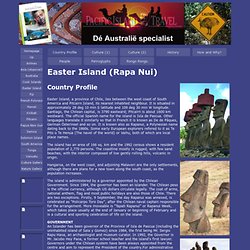
It is situated in approximately 28 deg 10 min S latitude and 109 deg 30 min W longitude. Santiago, the Chilean capital, is 3790 eastward; Pitcairn is about 1600 km westward. The official Spanish name for the island is Isla de Pascua. Other languages translate it similarly so that in French it is known as Ile de Pâques, German Österinsel and so on. It is known also as Rapanui, a Polynesian name dating back to the 1860s. Imagina Easter Island. Aereal view of Ahu Te Pito Kura Following the road on the north coast, facing a fishing cove in La Perouse Bay, Ahu Te Pito Kura can be found.
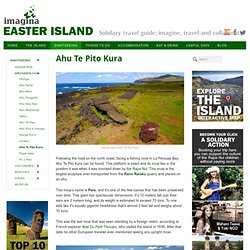
This platform is intact and its moai lies in the position it was when it was knocked down by the Rapa Nui. This moai is the largest sculpture ever transported from the Rano Raraku quarry and placed on an ahu. easter island faces, easter island stone henge This moai’s name is Paro, and it’s one of the few names that has been preserved over time. This giant has spectacular dimensions. Rapa Nui « Murray Foote « Page 2. We arrived at Ahu Te Pita Kura in the morning of the 25th, after visiting Ovahe at dawn and then Papa Vaka.
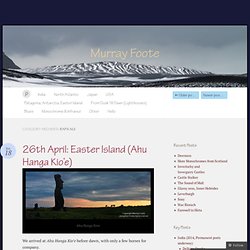
The moai here was the largest ever moved to an ahu at nearly 10 metres tall and weighing approximately 82 tonnes. As well as that, its pukao (topknot) weighed a further 12 tonnes. Moai Paro at Ahu Te Pito Kura. AHU TAHAI - EASTER ISLAND. General view of Tahai site This archaeological site was restored between 1968 and 1970 by American archaeologist William Mulloy and recreates the original layout of the Rapanui villages.
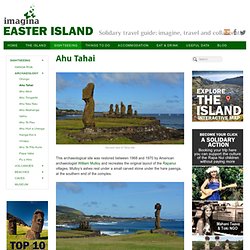
Mulloy’s ashes rest under a small carved stone under the hare paenga, at the southern end of the complex. View of Ahi Vai Uri and Ahu Ko te Riku The three ahu or ceremonial platforms found here are, from left to right, Ahu Vai Uri, which has five moais, Ahu Tahai; with a single and quite eroded moai; and finally, Ahu Ko Te Riku, on which a single moai stands equipped with eyes (a replica based on the eye found in Anakena in 1978) and a pukao (a red scoria headdress). This ahu displays the moais in their maximum splendor. Easter Island: land of mystery (1) Journal of the Polynesian Society: Easter Island's Position In The Prehistory Of Polynesia, By Kenneth P. Emory, P 57-69. Mysterious Places: Explore sacred sites and ancient civilizations. Wild speculation about UFO's, Atlantis, and vanished advanced ancient races has always been a part of the Easter Island debate.
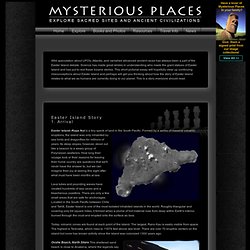
Science has made great strides in understanding who made the giant statues of Easter Island and has put to rest these bizarre stories. This short pictorial essay will hopefully clear up continuing misconceptions about Easter Island and perhaps will get you thinking about how the story of Easter Island relates to what we as humans are currently doing to our planet. This is a story everyone should read. Easter Island Story 1. Arrival Easter Island--Rapa Nui is a tiny speck of land in the South Pacific. Inhabited by sea birds and dragonflies for millions of years. Lava tubes and pounding waves have created hundreds of sea caves and a treacherous coastline.
Ovahe Beach, North Shore This sheltered sand beach is close to Anakena, where the legends say King Hoto Matua landed his double hulled canoe, thus beginning the occupation of Easter Island. 2. 1. Easter Island: Culture/Tradition. Undoubtedly, the excellent characteristic of the culture rapanui are the statues moai, dedicated in memory of the ancient chiefs and that presidiaban from your altar, the ahu all the activities of the settlements constructed concerning the platform and near a bay.
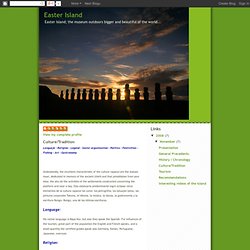
Esta estatuaria predominante logró eclipsar otros elementos de la cultura rapanui tal como: los petroglifos, los tatuajes tatoo, las pinturas corporales Takona, el idioma, la música, la danza, la gastronomía y la escritura Rongo- Rongo, una de las últimas escrituras. Language: His native language is Rapa Nui, but also they speak the Spanish. (a)tua. Signs that look like a canoe or a fishhook provide possible clues to their phonetic values.
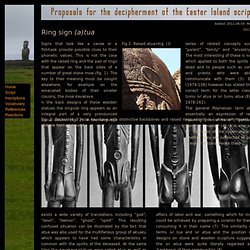
This is not the case with the raised ring and the pair of rings that appear on the back sides of a number of great stone moai (fig. 1). The key to their meaning must be sought elsewhere, for example on the emaciated bodies of their smaller cousins, the moai kavakava. N the back designs of these wooden statues the singular ring appears as an integral part of a very pronounced spinal column (fig. 2). Religion and expressive culture - Easter Island. Easter Island: land of mystery (2) Polynesian Mythology: Easter Island. On Easter Island, as throughout Polynesia, the people maintain an oral tradition in the form of songs and stories about their mythical gods and heroes who had the strengths and weaknesses of men, and into tales of history about noble ancestors who bore the names and attributes of gods.

A figure from Easter Island, made of tapa cloth stretched over bound bullrushes and decorated with a tattoo pattern. Usually placed near the door of a house, it was believed to offer protection against evil spirits. Easter Island. The Moai statues of Rapa Nui (Enlarge) One of the world's most famous yet least visited archaeological sites, Easter Island is a small, hilly, now treeless island of volcanic origin.
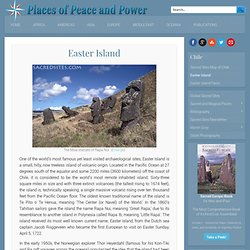
Located in the Pacific Ocean at 27 degrees south of the equator and some 2200 miles (3600 kilometers) off the coast of Chile, it is considered to be the world’s most remote inhabited island. Sixty-three square miles in size and with three extinct volcanoes (the tallest rising to 1674 feet), the island is, technically speaking, a single massive volcano rising over ten thousand feet from the Pacific Ocean floor. Expeditions to the Seafloor. History of Oceanography Click on the arrows below to learn more Polynesian Seafarers Masters of Ocean Currents.
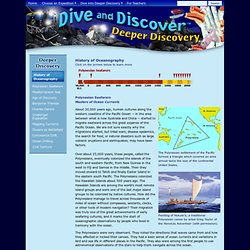
RAPA NUI RELIGION AND BELIEFS. The Easter Island inhabitants’ life, as well as in Polynesian cultures, was organized around their Rapa Nui religion and spiritual beliefs. These beliefs and their evolution significantly affected the course of history. rapa nui religion and beliefs The religious rituals started from birth, when the umbilical cord was cut, and extended through their whole lives, including rituals for the first haircut, the first tattoos, initiation and coming of age rituals. rapa nui religion and beliefs, easter island religion But perhaps the most important rituals, that most affected Rapa Nui art and history, were the ones associated with death.
The Rapa Nui believed that their forefathers’ spirits had the ability to come to their aid in case it was necessary, since the spirit remained around his relatives for a long time before leaving for good. Easter Island - Ancient Civilizations Lesson Plans, Presentations, Activities, Games, Learning Modules for Kids. The Fate of Easter Island. Inquiry: AN OCCASIONAL COLUMN Can what happened on one South Pacific island serve as a cautionary tale for the planet as a whole? By Peter Tyson Posted 04.20.04 NOVA To see just how clearly a growing human population relies on and impacts its natural environment, one need look no further than Easter Island, the South Pacific isle with the famous stone statues known as moai. Easter Island and Lessons Learned! Strangely enough, Easter Island is a great topic to discuss right now, because of it's history, Easter, and "Arbor Day" all have something in common... As I go on, you will see what I mean...
Easter Island is located at the southeastern most point of the Polynesian Triangle. (Territory of Chile.) It is famous for it's statues, called moai, made by the Rapanui people. 6_rapa.pdf. Language Arts Activity - The Mystery of Easter Island. Consequences of Deforestation on Easter Island. An archaeological analysis of Rapa Nui settlement structure: a multi-scalar approach. Iii Project (LOMAP). She also offered me valuable professional, academic, and personal adviceover the years andI thank her for always providinga balanced perspectiveon archaeologicalresearch.Manyaspects of my research on Rapa Nui have been influenced significantly byconversations withCarl P. Lipo. He has always provided me with thought-provokingdiscussionson a range of methodological and theoretical issues.
His ability to see through to thevery central core of research questions and offer clear and concise solutions isunmatched.ChipFletcher acted as an exemplary university representative committee member. Easter Island, Moai, Rongorongo. Social and political organization - Easter Island. Facts About Rapa Nui (Easter Island) Jo Anne Van Tilburg, Ph.D. Location Lying isolated in the East Pacific, in an extreme windward position, Rapa Nui is the easternmost Polynesian island. It is in the Southern Hemisphere at 27° 9’ S latitude, 109° 26’ W longitude. Situated on the Nazca Plate at a volcanic and tectonic “hot spot,” it is 3703 km west of South America and 1819 km east of Pitcairn island. The total land area is 163.6 sq km or 63.2 sq mi.
Easter Island. “The statues walked,” Easter Islanders say. Archaeologists are still trying to figure out how—and whether their story is a cautionary tale of environmental disaster or a celebration of human ingenuity. By Hannah Bloch Video Animation by Hans Weise, Spencer Millsap, Fernando G. Teacher Librarian Help. Recently I presented at an HTAV conference the ten sorts of searches and resources I look at before I do an open topic Google search.
The following research guide is an example of how the ten steps work and as such is not set up in the same way as other guides. It is still a collection of resources but it is not presented in a student friendly way. You need to work out what you like and how you are going to use it. The ten steps are as follows (I am not saying don’t use Google, rather use Google in a targeted way) BEFORE you start you need to key words etc. Australian Curriculum – The Polynesian expansion across the Pacific (c.700 – 1756) Secrets of Easter Island. Easter Island: stones, history. NMNH Centennial - Moai or Easter Island Stone Figure. A History of the World - Object : Hoa Hakananai'a Easter Island statue. Pioneers of Easter Island. By Liesl Clark Posted 02.15.00 NOVA. Travel - Slideshow - The mysteries of Easter Island.
Wayfinders : Polynesian History and Origin. Polynesians: An Oceanic People | European Explorers | Linguistic Evidence/Oral Traditions | Heyerdahl and Sharp | The Archaeological Response | Experimental Voyaging | Hokulea: The Rediscovery | Introduction. The Mystery of Easter Island- page 2. Light at The Edge of The World - The Wayfinders. Chapter I. — Physical and Geological Features of Polynesia.—Volcanic, Crystalline, and Coral Islands; Atolls, Barrier Reefs, etc. Page break coral island, with central lagoon. Www.polynesian-prehistory.com.